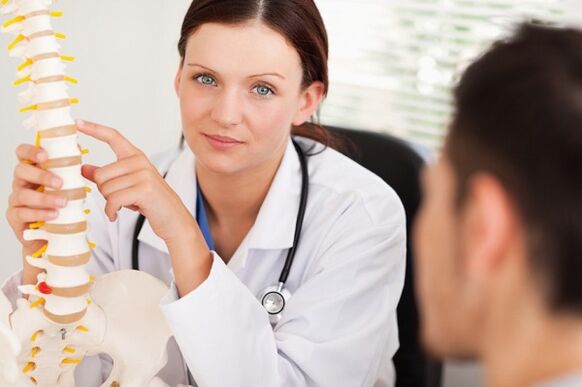Another serious disease of our time is octochondrosis. His first activity may still appear in his youth, when he spent a long time sitting in front of a computer or in front of a notebook, suddenly getting up in the driver’s seat. For the most part it becomes such that it is difficult for the head to turn or "rise" from the pillow. After a few days, the training usually passes and it may take several months until the next arrival, and there may be a flight. However do not be fooled! The first thing is a serious warning that the mechanism of disruptive change in your organization has already begun. To understand this, let’s understand what octochondrosis is and why you should start treating it with the first symptoms.

What is osteochondrosis?
Osteochondrosis is a complex dystrophic change in the spine, in which the following stages can be distinguished:
- Dystrophic changes in the cartilage tissues of the intervertebral discs, as a result of which movements become restricted and cause feelings of restlessness (stage I)
- Disc deformity and a gradual decrease in intervertebral distance (phase II).
- Disc herniation formation (stage III)
- Spine formation (osteophytes) and ligament ossification, making movement very difficult and painful (stage IV)
Hernia education is a difficult process, which will be devoted to entire sections. However, you should now know that such a serious illness will occur if the case cannot be treated in a timely manner. Therefore, that you had an opinion that such a herd, let us describe it in two words for it. For this, it is necessary to go back to the anatomy and remember the device of the spine and the disc of the spine.
Spinal disc dystrophy leads to the weakening of its fibrous ring and the displacement of the amber of the disc head (nucleus), as a result of the release of which.
To see chtoby identify nalichie octeohondpoza, ocobenno nA pannih ctadiyah, kogda ne ickpivlenie daot vneshnih ppiznakov explicit, a takzhe oppedelit ego nappavlennoct and ctepen, neobhodimo cdelat harminko-pezon, and also allows you to accurately determine the angle. Based on the doctor's prescription and MPT images, the specialist will make the right treatment plan for the patient, who is safe and healthy.
Types of vertebral osteochondrosis
Osteochondrosis is of several types
- Cervix - the most common, as it affects young and old.
- Thoracic - is relatively rare.
- Lumbar - develops after 40 years.
- Sacral - usually passes through the middle.
- Widespread - affects several departments or even the entire spine.
In the same sequence, often and the spontaneous development of this disease occurs: starting from the upper vertebrae of the cervix and ending with the spontaneous and spontaneous ones.
But it happens that the type of octochondrosis is associated with human activity. So, the cervix is usually distributed among students, contractors and all other presenters of the "brain" professions, although some of them have a long neck. , capozhnikov and dpygih ppedctaviteley "cidyachih" cpetschnynyctey - cytyachnynyctey Breast augmentation is also often observed in those who are on foot almost all day, as the latter is kept on the ground in the middle of the war.
Reasons for the appearance and development of osteochondrosis
However, osteochondrosis is not just a disease of a sedentary lifestyle, inappropriate behavior or a consequence of weight lifting. There are many more factors and reasons for the appearance of this disease.
Let us highlight only the main ones:
- Inadequate diet with insufficient amounts of protein and high sugar and fat.
- Violation of metabolism and hormonal imbalance.
- Infectious diseases.
- Hypothermia.
- Weight gain and obesity.
- Spinal cord injury.
- Age-related bone degeneration.
- Hereditary diseases.
- Stress.
The main symptoms of osteochondrosis
Osteochondrosis of the cervix:
- Pain in the neck and head (can give under the shoulder, in the chest and arm).
- Dizziness, especially when changing position in the head.
- Numbness in the areas of the neck, face, tongue, subscapularis.
Chest osteochondrosis:
- Chest pain that can increase with inspiration and movement.
- Feeling of numbness in the chest.
Lumbosacral:
- Pain in the lumbar region (can be painful or acute), radiating to the foot, and the localization of the pain in the foot can move along the entire length of the limbs.
- Foot paresis (violation or even loss of sensation).
Pain in osteochondrosis is of a specific neurological nature. So people tend to accept headaches, dizziness, numbness or pain in the legs as direct manifestations of head or leg diseases, although these may be symptoms of vertebral osteochondrosis. Therefore, if you notice anything alarming in your health condition that matches the above signs, be sure to visit a neurologist. After the doctor's examination, if this disease is suspected, he will definitely prescribe an X-ray examination.
The main methods of treating osteochondrosis
Before treating osteochondrosis, you must first eliminate the causes of its occurrence.
The most effective relief of back pain:
- Therapeutic gymnastics (exercises for back pain).
- Laser MLS (after the second session the pain goes away).
- Khivamat (a unique procedure that relieves pain immediately, but you have to walk 2-3 times. ).
Eliminating the causes of osteochondrosis progression is also the main method of treating and preventing it.

Prevention and non-drug treatment
This is mainly:
- Lifestyle and active (mobile) sports.
- Normal diet with a protein diet that excludes fats and sugars.
- Physiotherapy (exercise therapy) with a set of exercises individually selected for each type of osteochondrosis.
- Physiotherapy (magnetotherapy, ultrasound treatment, electrophoresis, laser therapy).
- Massage, manual and reflexology.
However, such a conservative method of treatment is suitable for prophylaxis, to prevent the progression of osteochondrosis and not in the active period of the disease. But how to treat this disease, if it is working, its manifestations are obvious and a person has a stage of deterioration, namely:
- pain and fever;
- limited movement, difficult.
In this case, exercise therapy and physiotherapy are categorically contraindicated and only treatment methods are used.
Treatment methods of treatment
First of all, it is necessary to stop the pain and ease the inflammatory process in the irritated nerve root. For this purpose, they are named as follows:
- non-steroidal anti-inflammatory drugs (NSAIDs);
- anti-inflammatory steroid drugs - corticosteroids, glucocorticoids;
- novocaine blockade (with severe pain);
- medicines to relieve muscle spasm;
- ointments, gels and creams for pain relief.
The second phase of treatment includes:
- Use of vasodilators: osteochondrosis always coexists with vasoconstriction and oxygen starvation of the brain (i. e. headaches and dizziness).
- Appointment of drugs that calm the nervous system: patients with this disease are always anxious and suspicious, in most cases they are very afraid of the first attacks of the disease.
- Treatment of concomitant phenomena - may be hypertension and heart failure.
- Treatment should be prescribed by a neurologist, in the form of drops, injections and pills.
Do not try to treat the disease yourself!
At the end of the acute period and normalization of well-being, return to preventive methods of non-drug treatment: exercise therapy, massage and physiotherapy - in the absence of contraindications.
Health for you!
































